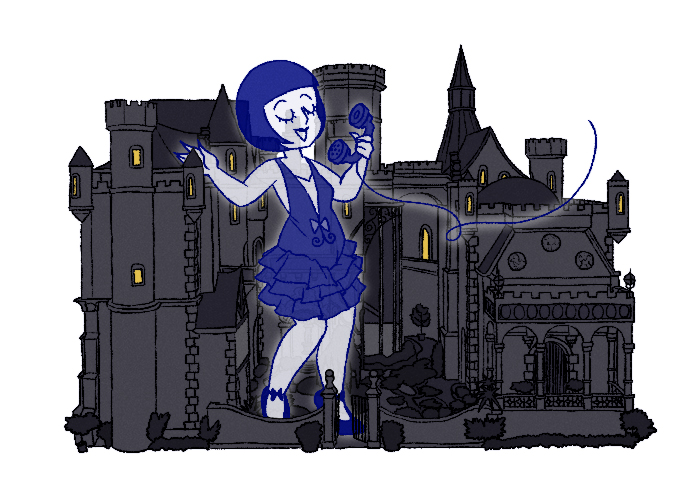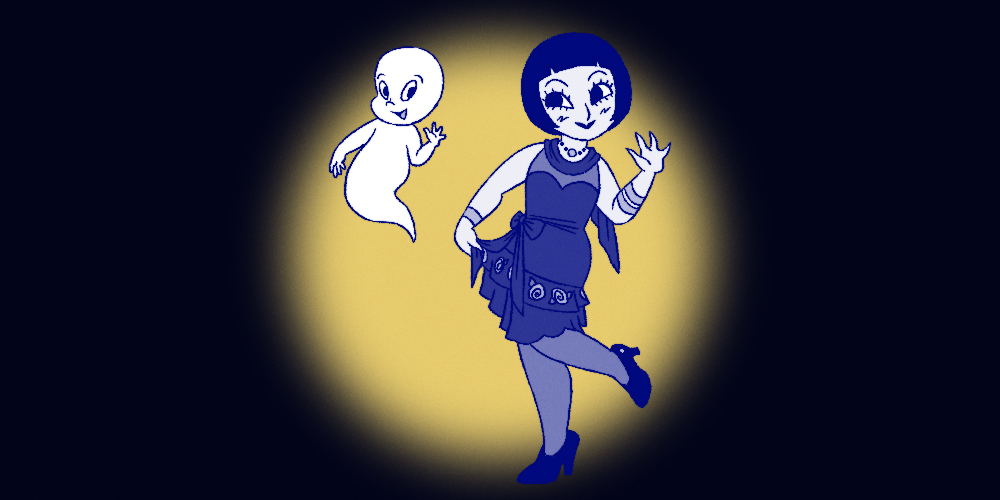Scarier than the thought of ghosts is the thought of no ghosts.
Ever since I was a kid, watching re-runs of ancient cartoons at my Grandma Marge’s house in Hubbard, Nebraska, I’ve been a fan of Casper the Friendly Ghost, especially the original episodes from the late 1940s. The first installment opened with baritone radio announcer Frank Gallop intoning: “There are some people who believe in ghosts, and there are some people who don’t. If you’re the believe-in-ghosts kind, then this story is about one. And if you’re the don’t-believe-in-ghosts-kind, well, just for fun, this story is about one anyway.”
I believed, I wanted to tell Frank Gallop; I was in the former category, even though I’d never yet been lucky enough to see one.
The initial image of Casper on screen shows him asleep under a copy of Dale Carnegie’s How to Win Friends and Influence People. A nonconformist among phantoms, his fondest wish is to befriend humans, not frighten them.
Although I enjoy being scared, I’ve always been drawn to the figure of the benevolent spirit. Meeting a friendly ghost would still make you question everything you thought you knew about the way the world works. Hostility or terror need not be prerequisites.
Casper aside, though, friendly ghost stories remain challenging to come by.
That’s probably why my mind was blown when I first encountered the great British ghost story writer Algernon Blackwood’s “The Other Wing.” It was April of 2017. I read it on an airplane. Studies show that being airborne makes humans more prone to weeping, but the tale would have moved me no matter where I read it.
“It used to puzzle him that, after dark, someone would look in round the edge of the bedroom door, and withdraw again too rapidly for him to see the face,” the story begins, focused upon the child protagonist. “When the nurse had gone away with the candle this happened: ‘Good night, Master Tim,’ she said usually, shading the light with one hand to protect his eyes; ‘dream of me and I’ll dream of you.’ She went out slowly.”
The reason I admire this story so much that I now teach it to my fiction classes at DePaul University lies largely in Tim’s calm curiosity regarding the haunting: “‘It comes from the Nightmare Passage,’ he decided; ‘but it’s not a nightmare.’ It puzzled him.” I won’t spoil the story by saying what the ghost’s identity and aims turn out to be, but “The Other Wing” depicts the kind of encounter that I aspired to have should I ever be fortunate enough to finally meet a ghost.
Silent movies are full of friendly ghosts. If you watch one, even one of the most recent ones possible from the silent era, say 1929, today, in 2023, then you know that every person in it is almost certainly dead. Yet something about the style and energy of the acting of that era makes these long-gone people on the screen more unearthly, more haunting to me than talking pictures. Something about the luminosity of the film itself — when it’s shown well, as on a high-quality print played at the proper speed — and the dimness — when it’s shown poorly, as on a badly degraded copy or on YouTube — gives them, to my eyes, a phantasmic aura.
According to the Library of Congress, an astonishing 75 percent of all movies made before the introduction of sound (the first talkie, The Jazz Singer, premiered in 1927) are lost forever, due to studio fires, deliberate destruction, improper preservation, and the natural volatility of the silver nitrate film, prone to combust spontaneously and to burn robustly even when fully immersed in water. To be a silent star is to be almost completely, but maybe imperfectly, physically gone; to be a fan of silent films is to feel as though you’ve been given the gift of seeing the dead.
Experts would say that this silvery, and to me ghostly brilliance, is a consequence of literal silver — the silver nitrate film stock that silent pictures were shot on. In an interview with Sight and Sound in 2011, silent film expert Kevin Brownlow spoke of how he remembered “at the National Film Theatre showing a dim 16mm dupe of a Colleen Moore comedy called Orchids and Ermine (1927). It was the usual thing that laboratories subjected us to in the 1960s. Then the projectionist switched over to the same scene in original nitrate. The audience gasped. The difference was indeed breathtaking. The 16mm barely registered. The 35mm looked stereoscopic — you felt you could walk into it.”
My favorite silent movie star is Colleen Moore, who popularized the figure of the flapper on screen. She died in 1988. In her heyday, there was no one more famous. In 1927, at the height of her Hollywood money and acclaim, the Los Angeles Times called her “Peter Pan with a collegiate figure and a Wall Street brain.” Her bobbed hair sent millions of women to the beauty shop and her chopped locks were as much of a signature as Charlie Chaplin’s mustache, Harold Lloyd’s glasses, or Buster Keaton’s porkpie hat.
She’s almost totally forgotten today, save that her astonishing doll house, known as the Fairy Castle, resides in the basement of the Museum of Science and Industry here in Chicago. I first laid eyes on it when I was eight years old, smitten by its abundance of fairy tale detail: the polar bear rug that was really an ermine skin embellished by a taxidermist with mouse’s teeth to look especially fierce, or the library with its collection of books autographed by the likes of F. Scott Fitzgerald and Edna Ferber. When I first visited, you could pick up a heavy black telephone receiver and hear Moore herself tell you that, “This furniture is made for fairy folk who like to read in different positions. That chair turned up in front is made for a little elf who likes to read with his feet in the air.” A long-dead woman speaking directly into your ear of supernatural beings with apparently total belief!

It would be years before I would be able, as an adult, to track down and watch every single one of the 60-plus silent pictures she made in her lifetime that were still available, which alas, still is far from a majority of them. Moore emanates intelligence and joie de vivre in her every role, embodying a curiously modern attitude that makes me feel that if she were to walk off the screen and into my living room, then the two of us would become fast friends.
She grew up listening to her Irish grandmother tell supernatural tales of fairies in Ireland and harbored a lifelong belief in them. Celtic folklore contains the notion of “thin places,” locations where the veil between the world humans can see and whatever lies beyond it becomes thin and permeable. Fairies and spirits can come through to our world, and some of us can pass through to theirs.
It’s fair to say, figuratively, that Colleen Moore has been haunting me ever since I started writing a novel about her — her film career, her obsession with miniatures, her incredible doll house — back in December of 2016. But only figuratively.
Then, about one year after I read Blackwood’s tale, my wish to encounter a friendly ghost came true. It was March of 2018 and my spouse Martin and I were in Tampa attending a conference. Colleen Moore grew up in Tampa.
Shortly after our arrival, we were walking around near the convention center, trying to soak up some Florida sunshine before we spent the next few days indoors.
I knew from my research that Colleen had lived in the city in the 1900s and early 1910s, but had no idea where exactly. As Martin and I crossed an intersection near Tampa Bay on a street called Magnolia, I experienced what I can only describe as an intense sensation of presence. Martin was striding ahead, longer-legged than I am. I stopped at the corner of an old bricky road, the better to feel the present feeling. Out loud, a woman’s voice, friendly, said “Hey” as clear as the sunlight. I knew it was her, Colleen. I called to Martin to come back and looked in my phone for what her address had been. I didn’t have it anywhere. But I performed a Google Book Search in the one extant biography to try to see if it was listed, and it was. The intersection where we were standing was her intersection, where she and her brother used to run down their stairs and jump into the ocean. Her house wasn’t there anymore, having been obliterated by a SunTrust Bank parking lot and a roaring highway. But Colleen had spoken to me anyway because she wanted me to see the spot.
In the original cartoon from 1948, Casper the Friendly Ghost attempts suicide. No one will be his friend — scared, they all turn pale and run away when he approaches. Forlorn, he lies down on the tracks in front of a speeding freight train. Casper has forgotten, obviously, that he is already dead, and the locomotive causes him no harm. But his actions made a big impression, and I vowed that if I ever got to meet a ghost, then I wouldn’t be scared. And I wasn’t.
In his 1889 book Fairy & Folk Tales of Ireland, W.B. Yeats writes, “Many poets and all mystic and occult writers, in all ages and countries, have declared that behind the visible are chains on chains of conscious beings, who are not of heaven but of the earth, who have no inherent form but change according to their whim or the mind that sees them. You cannot lift your hand without influencing and being influenced by hordes. The visible world is merely their skin.”
It’s too depressing to think that the visible world is all that there is. Skinless themselves, ghosts peel back the skin of the ordinary, giving us, if not a complete picture of the beyond, then at least the invaluable sense that the beyond exists.•




